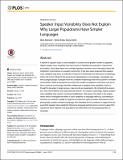Files in this item
Speaker input variability does not explain why larger populations have simpler languages
Item metadata
| dc.contributor.author | Atkinson, Mark | |
| dc.contributor.author | Kirby, Simon | |
| dc.contributor.author | Smith, Kenny | |
| dc.date.accessioned | 2020-11-02T10:30:05Z | |
| dc.date.available | 2020-11-02T10:30:05Z | |
| dc.date.issued | 2015-06-09 | |
| dc.identifier | 270929142 | |
| dc.identifier | 14e18861-5a3a-437e-90ae-afae05a96af1 | |
| dc.identifier | 000356349000055 | |
| dc.identifier | 84936882032 | |
| dc.identifier.citation | Atkinson , M , Kirby , S & Smith , K 2015 , ' Speaker input variability does not explain why larger populations have simpler languages ' , PLoS ONE , vol. 10 , no. 6 , e0129463 . https://doi.org/10.1371/journal.pone.0129463 | en |
| dc.identifier.issn | 1932-6203 | |
| dc.identifier.uri | https://hdl.handle.net/10023/20874 | |
| dc.description | MA is supported by an Arts & Humanities Research Council (http://www.ahrc.ac.uk) PhD Studentship (grant number AH/K503010/1). | en |
| dc.description.abstract | A learner's linguistic input is more variable if it comes from a greater number of speakers. Higher speaker input variability has been shown to facilitate the acquisition of phonemic boundaries, since data drawn from multiple speakers provides more information about the distribution of phonemes in a speech community. It has also been proposed that speaker input variability may have a systematic influence on individual-level learning of morphology, which can in turn influence the group-level characteristics of a language. Languages spoken by larger groups of people have less complex morphology than those spoken in smaller communities. While a mechanism by which the number of speakers could have such an effect is yet to be convincingly identified, differences in speaker input variability, which is thought to be larger in larger groups, may provide an explanation. By hindering the acquisition, and hence faithful cross-generational transfer, of complex morphology, higher speaker input variability may result in structural simplification. We assess this claim in two experiments which investigate the effect of such variability on language learning, considering its influence on a learner's ability to segment a continuous speech stream and acquire a morphologically complex miniature language. We ultimately find no evidence to support the proposal that speaker input variability influences language learning and so cannot support the hypothesis that it explains how population size determines the structural properties of language. | |
| dc.format.extent | 20 | |
| dc.format.extent | 1179703 | |
| dc.language.iso | eng | |
| dc.relation.ispartof | PLoS ONE | en |
| dc.subject | BF Psychology | en |
| dc.subject.lcc | BF | en |
| dc.title | Speaker input variability does not explain why larger populations have simpler languages | en |
| dc.type | Journal article | en |
| dc.contributor.institution | University of St Andrews. School of Management | en |
| dc.identifier.doi | 10.1371/journal.pone.0129463 | |
| dc.description.status | Peer reviewed | en |
This item appears in the following Collection(s)
Items in the St Andrews Research Repository are protected by copyright, with all rights reserved, unless otherwise indicated.

